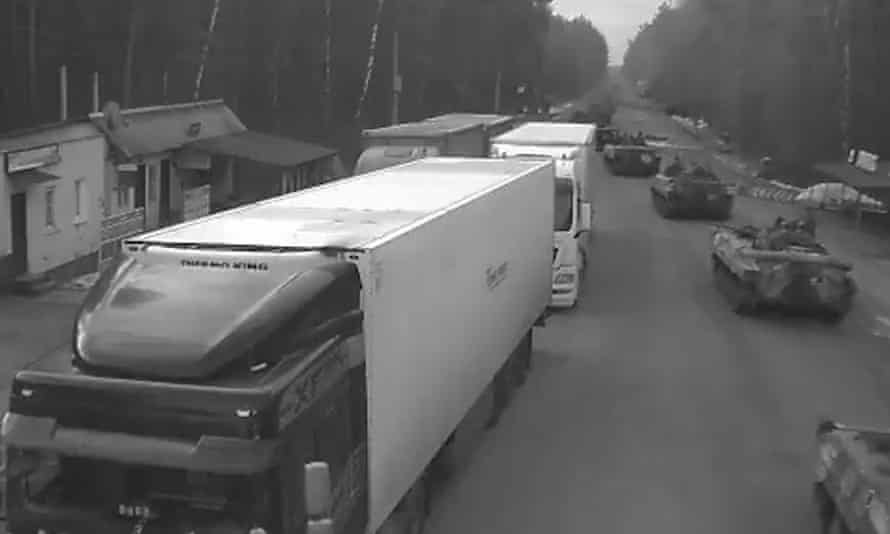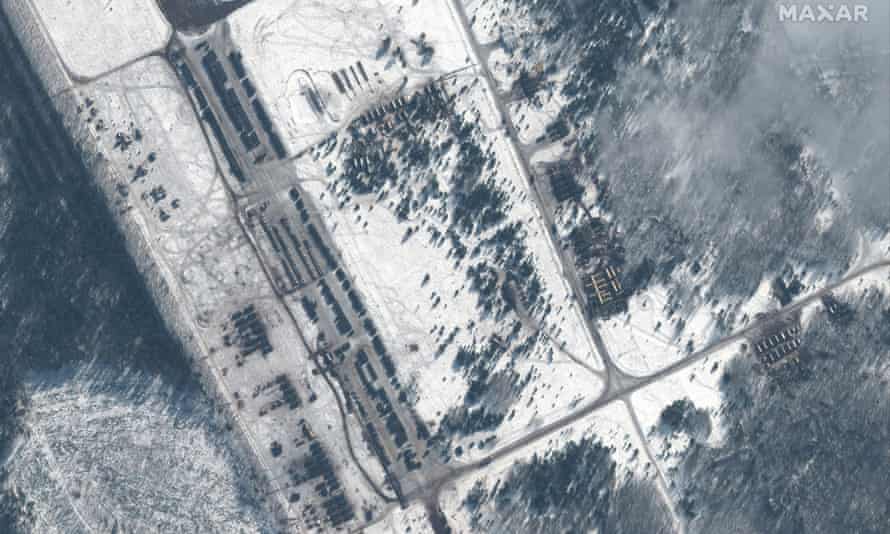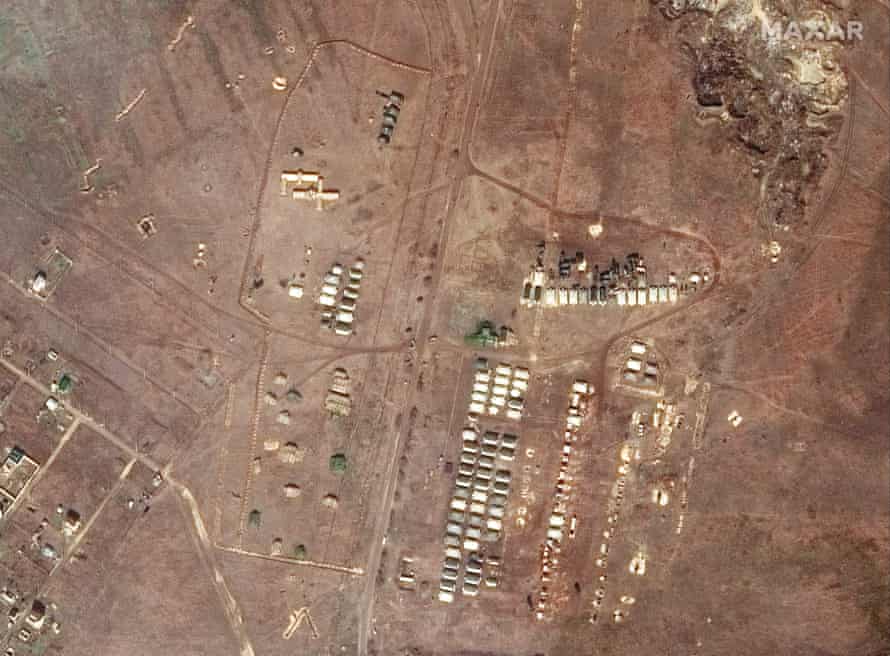Russian forces have reached the outskirts of Kyiv and carried out an amphibious assault from the Sea of Azov near Mariupol, a day after attacking Ukraine from three sides on a massive scale.
In the capital air raid sirens wailed and heavy gunfire and explosions were heard in a number of districts, as Russian military vehicles approached from the north-west.
The defence ministry in Moscow claimed its forces had taken control of the strategic Hostomel airfield to the north-west after a day of fighting.
Pressure was also intensifying around Chernihiv, about 90 miles (145km) north-east of Kyiv, Ukraine’s military said, with Russian forces trying to bypass the city and head to the capital down the E95 road to Kozelec and ultimately Kyiv’s eastern suburbs. Further east, about 125 miles from the capital, the city of Konotop was lost to Russian forces.
According to the Pentagon, 10 amphibious landing ships unloaded thousands of naval infantry to the west of Mariupol, potentially cutting off the port city on the Sea of Asov. Fighting was reported to be continuing around Kherson on the Dnieper River and in Melitopol.
Elsewhere, Ukraine’s forces were believed to be holding firm in the eastern Donbas region, while the eastern city of Kharkiv, which has a population of more than 1 million, was gradually being surrounded.
What happened on Thursday?
Russia attacked Ukraine along multiple axes, bringing to a calamitous end weeks of fruitless diplomatic efforts by western leaders to avert war.
Fighting and other military activity took place around and on the way to Kyiv, including an ambitious attack by helicopters on the Hostomel military airbase.
Ukraine lost control of the Chernobyl nuclear site in the north, where fighting raged after Russian troops crossed the border from Belarus. One Russian line came through the Senkivka border crossing near Chernihiv.

A substantial attack was also aimed towards the eastern city of Kharkiv.
Russian forces also headed north and east from Crimea. Social media footage showed them reaching Kherson on the Dnieper, 80 miles (130km) inside Ukraine.
How did we get here?
Over the past few months Russia has forward-deployed hundreds of tanks, self-propelled artillery and even short-range ballistic missiles from as far away as Siberia to within striking range of Ukraine.
Moscow’s rhetoric also grew more belligerent. Vladimir Putin demanded legal guarantees that Ukraine would never join Nato or host its missile strike systems, concessions he was unlikely to receive. A flurry of diplomatic activity did little to ease tensions.
The second half of February was long seen as the most likely period for a potential offensive. Russian soldiers stayed on in Belarus beyond the end of planned military exercises, and the Winter Olympics, hosted by ally China, concluded.
The invasion was preceded on 22 February by Putin saying Russia would recognise the territorial claims of its two proxy states in east Ukraine. He had already ordered his forces into Russian-controlled territory in Ukraine.
On 22 February a Reuters witness saw columns of military vehicles including tanks and armoured personnel carriers (APCs) on the outskirts of Donetsk, the capital of one of the territories claimed by Russia.
What do we know about Russia’s deployments?
Scores of battalion tactical groups – the smallest operational unit in Moscow’s army, consisting of about 800-1,000 troops – were put in place near the borders of Ukraine in both Russia and latterly Belarus prior to the invasion. As of 18 February the US estimated that Russia had between 169,000 and 190,000 personnel in and around Ukraine.
An estimated 32,000 separatist forces were already operating in the breakaway areas of Donetsk and Luhansk – some of whom were likely to be unacknowledged Russian forces – before the invasion.
Many of the heavy weapons stationed near Ukraine arrived as far back as spring 2021. Over the new year Russia also began to move tanks, artillery, air defence systems and fighter jets to Belarus for joint exercises in February. That deployment has since grown.

Half of Russia’s air force is now deployed near Ukraine, according to western estimates. Russian warships conducted training exercises in the Black Sea in the run-up to the invasion. This footage released by the Russian defence ministry shows a Ka-27PS helicopter taking off and landing on the deck of a frigate during exercises on 22 February.
These satellite image composites show the buildup of troops in Yelnya and Pogonovo over the new year.
Satellite photographs also show increased deployments in Novoozernoye in western Crimea.
The US estimates 10,000 troops moved into Crimea in late January and early February. This image from 18 February shows deployments including armour, helicopters and field hospitals in Novoozernoye:

Satellite images taken on 20 February showed troops and equipment being moved from holding areas to what the UK defence secretary described as potential launch locations.
How do the militaries compare?
Russia’s invasion pits the Kremlin’s large, recently modernised military against an adversary largely using older versions of the same or similar equipment, dating back to the Soviet era. Russia has significant numerical advantages on land and in particular in air and at sea, although the Ukrainians are defending their homeland.
What is the historical context?
In 2014 Putin sent troops to annex Crimea, a mainly Russian-speaking region of Ukraine. Russia also incited a separatist uprising in Ukraine’s south-east, clandestinely sending soldiers and weapons to provoke a conflict that grew into a full-blown war.
A 2015 peace deal established a line of demarcation and called on both sides to make concessions. Since then low-level fighting has continued along the front, and both sides have accused the other of violating the agreement.
Going back further, Russia has long opposed any attempts by Ukraine to move towards the EU and Nato. One of Putin’s often repeated demands is a guarantee that Ukraine never joins Nato, the alliance of 30 countries that has expanded eastwards since the end of the cold war.
What is the role of Nord Stream 2?
On 22 February, the German chancellor, Olaf Scholz, stopped the certification process for the Nord Stream 2 gas pipeline in response to Russia’s recognition of the two self-proclaimed republics.
First announced in 2015, the $11bn (£8.3bn) pipeline owned by Russia’s state-backed energy company Gazprom has been built to carry gas from western Siberia to Lubmin in Germany’s north-east, doubling the existing capacity of the Nord Stream 1 pipeline and keeping 26m German homes warm at an affordable price.
Europe’s most divisive energy project, Nord Stream 2 bypasses the traditional gas transit nation of Ukraine by running along the bed of the Baltic Sea. It has faced resistance within the EU, and from the US as well as Ukraine, on the grounds that it increases Europe’s energy dependence on Russia, denies Ukraine transit fees and makes it more vulnerable to Russian invasion.
… we have a small favour to ask. Millions are turning to the Guardian for open, independent, quality news every day, and readers in 180 countries around the world now support us financially.
We believe everyone deserves access to information that’s grounded in science and truth, and analysis rooted in authority and integrity. That’s why we made a different choice: to keep our reporting open for all readers, regardless of where they live or what they can afford to pay. This means more people can be better informed, united, and inspired to take meaningful action.
In these perilous times, a truth-seeking global news organisation like the Guardian is essential. We have no shareholders or billionaire owner, meaning our journalism is free from commercial and political influence – this makes us different. When it’s never been more important, our independence allows us to fearlessly investigate, challenge and expose those in power. Support the Guardian from as little as $1 – it only takes a minute. If you can, please consider supporting us with a regular amount each month. Thank you.


Comments
Post a Comment